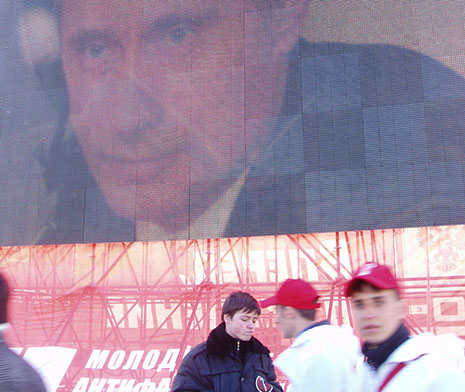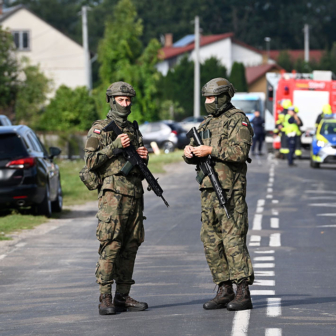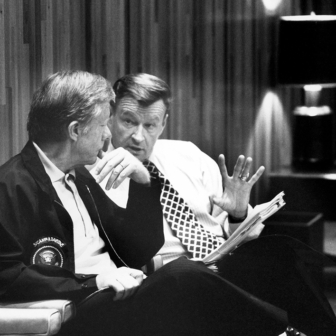IN MID OCTOBER a Russian historian researching the treatment of Germans in the Soviet Union during the second world war was arrested and charged with breaching privacy laws. The Guardian reported that Mikhail Suprun was detained by Russian security service officers, who searched his apartment and confiscated his research archives. His arrest came as a reminder of how the Stalinist era remains a live issue in post-Soviet Russian politics.
As if reminders were needed. Last year the Russian Academy of Sciences and the government-owned television network, Russia Channel, instituted a nationwide search for the historical figure that best represents the Russia of today. Modelled on the BBC’s 100 Greatest Britons, the project commenced with five hundred potential candidates for the title of “The Name of Russia.” By the end of the process Joseph Stalin had gathered enough votes to finish third, and rumours strongly suggested that the organisers had resorted to tampering with the votes to avoid the scandalous possibility that the Soviet leader would finish at the top of the list.
On the broadcast itself Stalin was presented as a flawed and ambiguous character. (“Flawed” must be the euphemism du jour of the early twenty-first century.) Yes, viewers were told, the man was known for occasionally pillaging and plundering, but let us not forget that he also turned a backward, agrarian and deeply dysfunctional country into an industrialised superpower. He was making an enormous omelette so can we please stop counting the broken eggs. Then, of course, the extra-heavy weaponry was wheeled out – the Stalin-led Soviet victory in the second world war. As achievements go, you can’t beat stopping Hitler from enslaving Europe and wiping the Soviet nation off the surface of the earth. In Britain, by the way, 100 Great Britons was won by Winston Churchill, who beat Diana, Shakespeare and Charles Darwin to the title.
The millions of votes cast for Stalin would have been simply inconceivable in the late 1980s and early 1990s. But by 2008, seventeen years after the collapse of the Soviet Union, things had changed. There were, of course, protests from democratic and human rights organisations and historians, who argued that the very fact that Stalin was on the list was completely unacceptable, particularly while his victims and their families were still alive. In Germany, as protesters pointed out, no Third Reich figures were allowed to be nominated in a comparable contest because they had long since been recognised as criminals. Not so in Russia. The organisers responded by appealing to the always handy principles of democracy. Surely an open discussion of Stalin’s significance in the history of his country was a sign of a healthy and robust civic society. As a Russian saying goes, “You cannot throw words out of a song.”
How do we make sense of the rehabilitation of the Soviet regime – and particularly the figure of Stalin – in present-day Russia? In the independent Russian media and in the western media, this phenomenon is rarely explained without reference to some kind of caricature. It may be the supposed masochistic craving for an iron fist deeply ingrained in the Russian psyche, or a case of a nationwide über-forgetting of mythic proportions. Or it might reflect the power of mass hypnosis attributed to the government of Vladimir Putin and Dmitry Medvedev.
THERE is no denying that the current government is engaged in a concerted campaign of rehabilitating all things Soviet – its leaders, its achievements and its legacy – minus, of course, the regrettable “excesses” of purges and forced collectivisation. After all, when he was still president Putin famously described the collapse of the Soviet Union as “the greatest geopolitical catastrophe” of the twentieth century. This campaign of rehabilitation can be seen in government rhetoric and in messages laundered through government-controlled media outlets, in the shutting down of archives and culling of history textbooks, and in the unlawful raids on the offices of the human rights and historical preservation society, Memorial – the most important voice for preserving the memory of Stalinism in Russia.
The rehabilitation of the Soviet era is also evident in the emergence of youth movements such as Mishki, the Russian word for teddy bear. Mishki’s full name is the Youth Organisation for the All-Round Development of Personality, Patriotic and Moral Education of Children and Youth. Yulia Zimova, its twenty-something-year-old founder, has told journalists that the movement’s aim is to teach children pride in their town and country, responsibility, independence and concern for others. It would sound like a harmless version of the Scouts if it had not been set up by members of Nashi, a youth organisation with strong links to the Kremlin, conceived as a Russian response to the Ukraine’s “Orange Revolution.” Some journalists who do not share Nashi’s devotion to Putin as Russia’s saviour have referred to the young members of the movement as “nashists,” and references abound to fascism and Hitler-Jugend, as well as to Soviet-era youth groups such as the Octobrists, Young Pioneers and Komsomol.
What does Nashi want? They want a full and swift restoration of Russia’s greatness. They want people to be dripping with pride in their country. They want the rest of the world, America and Britain in particular, to sit up and listen. (Shaking in fear will be the next step, of course, all things going to plan.) They want a “clean,” “strong” and “united” Russia, and that means sweeping the country with a big, long broom to rid it of all kinds of scum – ethnics, democrats, prostitutes. Nashi does not limit itself to ideological warfare; the movement offers paramilitary training to give its members the important life skills for breaking up opposition rallies. As a phenomenon, Mishki is both obscene (forced political participation of children is illegal even in Russia, to say nothing of being deeply immoral) and unintentionally hilarious, especially in its infantilisation of the political sphere. In all seriousness Mishki has asked Putin to become the head of their movement – the Chief Teddy Bear.
When Putin was still president one of Mishki’s slogans proclaimed, “Thank you Mr Putin for our stable future.” As the journalist Lev Rubinstein noted, this time Putin had outdone even Stalin. In Stalin’s times, the slogan was “Thank you to Comrade Stalin for our happy childhood.” Now Putin was being thanked for the future he apparently has rendered stable.
In fact, analogies between Putin and Stalin abound in popular culture. As do the jokes.
Stalin’s ghost appears to Vladimir Putin in a dream. Troubled by the crippled economy, Putin asks the Great Dead Leader for advice. “Round up and shoot all the democrats, and then paint the inside of the Kremlin blue,” Stalin replies. “Why blue?” Putin asks. “Ha!” says Stalin. “I knew you wouldn’t ask me about the first part.”
or
Putin gets up in the middle of the night and goes to the refrigerator. When he opens the door, a dish of jellied meat begins to tremble. “Don’t worry,” says Putin, “I’ve only come for a beer.”
It is, of course, all too tempting to think of Putin as the direct heir to Stalin and his brand of neo-totalitarianism as a far more moderate, modern and ideologically savvy version of Stalin’s iron fist. But like most historical analogies, this one is not particularly illuminating. As the Russian writer and journalist Dmitriy Bykov argues, “In the case of Putin we are dealing not with the cult of personality – since the personality barely manifests itself and, plus, it is hermetically sealed from strangers’ eyes – but with the cult of substance.”
This substance is virtually impossible to define. Because it encapsulates “collective expectations which are greater than any kind of logic,” it is “a phantom of mass self-hypnosis.” The way Bykov sees it, Putin’s rule is not comparable to Stalin’s cult of personality because Putin is not a personality but the archetypal man without qualities, the medium for the masses.
Arseniy Roginskiy, the chair of Memorial, argues that the rehabilitation of Stalin, as such, was not the objective of the current government. Rather, it was a by-product of the rehabilitation of the idea of Russia as a great nation and of the concerted campaign to re-legitimise the authority of the state, which began in the early 1990s. The vacuum left by the collapse of the Soviet regime was filled by certain heavily mythologised moments taken from Soviet history, with the Soviet victory in the second world war foremost among them. Sociologist Lev Gudkov points out that the victory of 1945 is, in fact, “the only positive reference point for the national consciousness of the post-Soviet society.” Surveys show that the identification of the war and the Soviet victory as the most important historical event of the twentieth century has only grown (and grown significantly) in the last decade or so. And the war is so inextricably linked with the figure of Stalin that any growth in its symbolic power is bound to increase Stalin’s legitimacy. In fact, the more the figure of Stalin is associated with the war, the weaker his links appear to be to the history of political terror and mass repressions.
Russian sociologist Boris Dubin suggests that contemporary Russia is “a society lacking in depth, characterised by flatness.” Quick to tire of anything complex or burdensome, it has been unable to hold on to a historical awareness of the crimes committed by the Soviet leadership, which were revealed under Gorbachev. Dubin believes that the outpouring and wide public circulation of memories of Stalinism in the late 1980s and 1990s was a tool of political confrontation between the reformers and the old regime. Once the Soviet Union collapsed, this confrontation was essentially exhausted and the urge to remember and to bear witness seemed to lose its cultural and social imperative. The idea that a strong and self-aware civic society is dependent on the active historical consciousness of its members has, he says, become an abstraction.
And, indeed, in a country in which, if you so much as scratch the surface of most family histories, you are likely to discover first-hand experiences of gulags, deportations and state terror, there are no legal processes by which the atrocities of Stalinism can officially be recognised and condemned as crimes against humanity. Unlike, say, South Africa or Argentina, Russia has had no Truth Commission, no Never Again report, no mechanisms to enable the nationwide work of testimony, witnessing and mourning. Russia has had nothing like the wholesale memorialisation of its traumatic history that we have seen in Germany or the United States. There is no central monument to the victims of terror. The location of most mass graves remains unknown, and streets across the nation still carry the names of Stalin’s henchmen. That victims of Stalinism and their families could receive an official apology like the one delivered by Kevin Rudd to Indigenous Australians is unimaginable.
ON THE SURFACE, this looks almost like a clinical picture of collective amnesia or, in psychoanalytic terms, the mass repression of mass repressions – only this is not quite the case. On the contrary, in today’s Russia can be found not an absence of memories of totalitarianism and Stalinism but a profound surplus. There is an incredibly rich, voluminous and constantly growing body of highly credible literature that painstakingly chronicles both specific experiences and the broader historical narratives underpinning the fate of millions of Soviet citizens killed, imprisoned, deported, sent to gulags or forced to live in constant terror. There is so much material, much of it available freely on the internet, that you could spend a lifetime reading. The historical legacy of Soviet terror, in other words, is being painstakingly remembered and just as painstakingly forgotten.
It must be said that the situation in Russia is markedly different from that in many other post-Soviet nations (and in countries of the former Eastern bloc more broadly). Ukraine and the Baltic states, for instance, are experiencing the process Ukrainian historian Gregoriy Kasyanov calls the “nationalisation” and “privatisation” of history. This kind of oppositional national history is used as the cornerstone for the revival of national consciousness and identity, an argument first for sovereignty and then for an unbroken tradition of a unified (and invariably democratic) national consciousness. And with historical narratives so firmly ensconced in the “politics” corner (however noble we may judge all aspirations of sovereignty and self-determination to be), what people choose to remember in public or semi-public forums very quickly becomes a question of allegiances and loyalty.
In Russia the picture is significantly more complex. While claims about the past are an integral part of political debates, the vast body of testimony and historical documents relating to the Soviet regime, and specifically to the history and legacy of Stalinism, has not been able to counter widespread forgetting or misremembering. By and large, attempts to mobilise this massive and constantly growing repository of private memories, public documents and historical work to act as an effective antidote to the falsification of historical accounts have failed. In the late 1980s and early 1990s it seemed as if social memory was the force that was going to put an end to the deployment of history as pure ideology – and then something went awry. It seems clear that the outpouring of people’s memories about what happened under Stalin did become part of Russia’s civic culture through the publication of survivor accounts, archival documents and serious works of history, through TV programs and films, but ultimately this outpouring has not been able to reconfigure Russia’s public sphere in any profound or lasting sense. The hardware has remained the same.
Russian historians based at Memorial point to the need to counter the persistent immateriality of the memory of Soviet totalitarianism as one of the most important historical battles they are facing today. For any true social change to occur, the victims of Stalinism, they say, need to be named. Their families need to know where their loved ones are buried. The material remains of gulags, prisons, mines and other types of industrial projects built on the slave labour of the camp inmates and special deportees need to be identified and marked. A central museum needs to be built. Memorials need to spring up in city centres rather than on the outskirts or as part of cemeteries. Plaques need to be put on the buildings where people were tortured and from which they were taken. Nothing, historians say, will stop people from forgetting until the memory of Soviet totalitarianism becomes part of the material fabric of Russian cities and towns, until children simply bump into things on their way somewhere and feel compelled to ask questions of their parents. It is a tragedy that at present their wish list seems outrageously implausible – almost as implausible as Stalin narrowly missing out on becoming “The Name of Russia.” •




